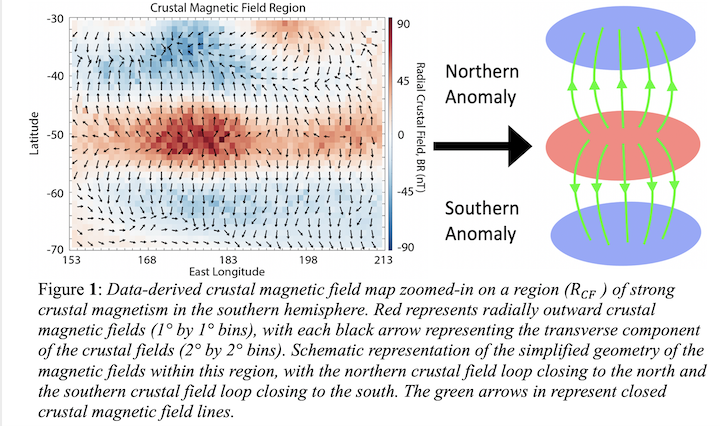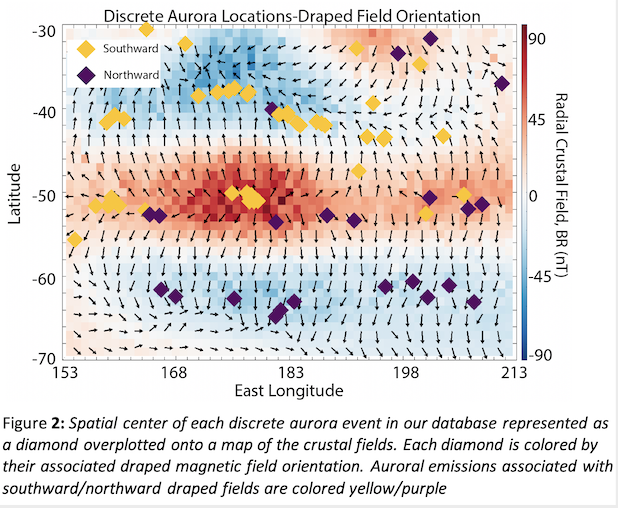Magnetic Reconnection and Discrete Aurora at Mars: MAVEN Observations
- 1University of Michigan, Ann Arbor, Climatology and Space Sciences and Engineering, Boulder, United States of America (@umich.edu)
- 2NASA Goddard Space Flight Center, Greenbelt, Maryland, United States of America (@nasa.gov)
- 3Laboratory for Atmospheric and Space Physics, Boulder, CO, United States of America
The localized crustal magnetic anomalies scattered across the surface Mars create a unique, hybrid magnetosphere. Over regions of strong crustal magnetism (100-1000 nT at the surface), the crustal anomalies protrude up to thousands of kilometers in space and a create a “mini-magnetospheric” interaction with the draped interplanetary magnetic field (IMF). One consequence of this interaction is the occurrence of discrete aurora on the nightside of Mars via electron precipitation and energy deposition into the planet’s atmosphere stimulating light emission (Bertaux et al., 2005). Discrete auroral emissions from electron impact with atmospheric CO2 in the mid ultra-violet have been observed via the Imaging Ultra-Violet Spectrograph (IUVS) instrument onboard the Mars Atmosphere and Volatile EvolutioN (MAVEN) spacecraft. These emissions have been preferentially observed over the region of strong crustal magnetism in the southern hemisphere (~153°-213° E longitude, 30°S-70°S latitude) and favor “open” magnetic field lines (i.e., one end connected to the IMF, the other connected to the planet) (Schneider et al., 2021). These trends suggest discrete aurora at Mars may form via magnetic reconnection between the strong crustal anomalies and the draped IMF around the planet. Magnetic reconnection is a process that can “open-up” the closed crustal magnetic fields at Mars and accelerate electrons along these magnetic field lines. However, there has yet to be a study that links these two phenomena directly, and as a result, our understanding of discrete auroral formation at Mars remains poorly understood.

In this study, we uncover the relationship between magnetic reconnection and discrete aurora at Mars by analyzing the draped magnetic field conditions during 78 discrete auroral emissions observed via nadir observations taken by the IUVS within the region of strong crustal fields. First, we simplify the crustal field region into its two primary constituents: one crustal anomaly that is positioned in the northern half of the region and closes northward, and one crustal anomaly that is positioned in the southern half of the region and closes southward (Figure 1). We note that the discrete auroral emissions tend to fall on the “footprints” of the two crustal anomalies where the dominant component of the crustal magnetic field points radially into or out of the planet. Two plasma regimes are more susceptible to reconnection when their magnetic field orientations are anti-parallel to one another. Therefore, we hypothesize that if crustal field-draped IMF magnetic reconnection plays a role in discrete auroral formation over the strong crustal anomalies at Mars, then a southward draped IMF would activate auroral emissions over the northern crustal anomaly and a northward draped IMF would activate auroral emissions over the southern crustal anomaly.

We estimate the orientation of the draped magnetic field over this region of strong crustal magnetism using data obtained from the magnetometer instrument onboard MAVEN along the same orbit in a discrete auroral emission was detected by IUVS. We find that the estimated orientation of the draped magnetic field associated with each discrete auroral event shows a regional dependence consistent with our hypothesis: discrete auroral emissions over the footprints of the northern anomaly are associated with southward draped fields, and emissions over the footprints of the southern anomaly are associated with northward draped fields (Figure 2). We also demonstrate that these findings hold implications for other trends reported in previous studies of discrete aurora over this region of crustal fields, namely a trend in local time and upstream IMF conditions. This study is the first to more definitively link magnetic reconnection to discrete aurora formation on the nightside of Mars.
Bertaux, J., F. Leblanc, O. Witasse, E. Quemerais, J. Lilensten, S. Stern, B. Sandel, and O. Korablev (2005), Discovery of an aurora on Mars, Nature, 435(7043), 790-794.
Schneider, N., et al. (2021), Discrete Aurora on Mars: Insights Into Their Distribution and Activity From MAVEN/IUVS Observations, Journal of Geophysical Research-Space Physics, 126(10).
How to cite: Bowers, C., Slavin, J., DiBraccio, G., Johnston, B., and Schneider, N.: Magnetic Reconnection and Discrete Aurora at Mars: MAVEN Observations, Europlanet Science Congress 2022, Granada, Spain, 18–23 Sep 2022, EPSC2022-170, https://doi.org/10.5194/epsc2022-170, 2022.